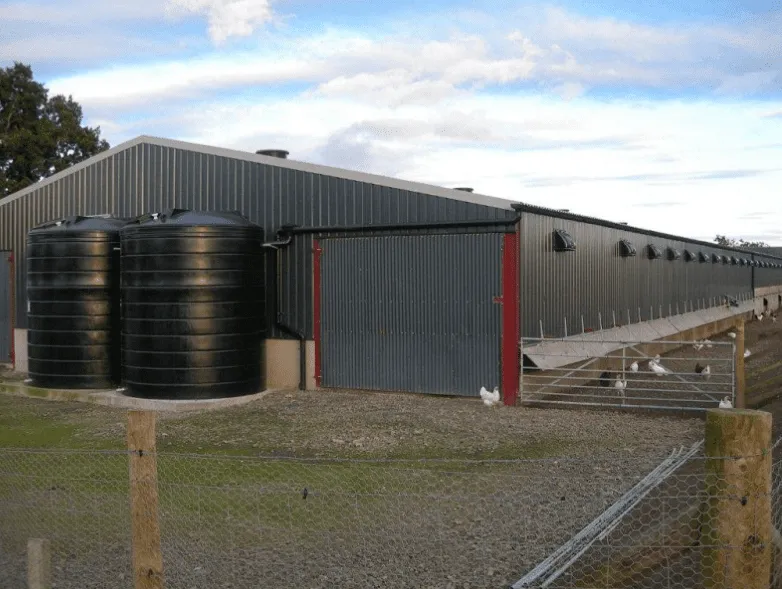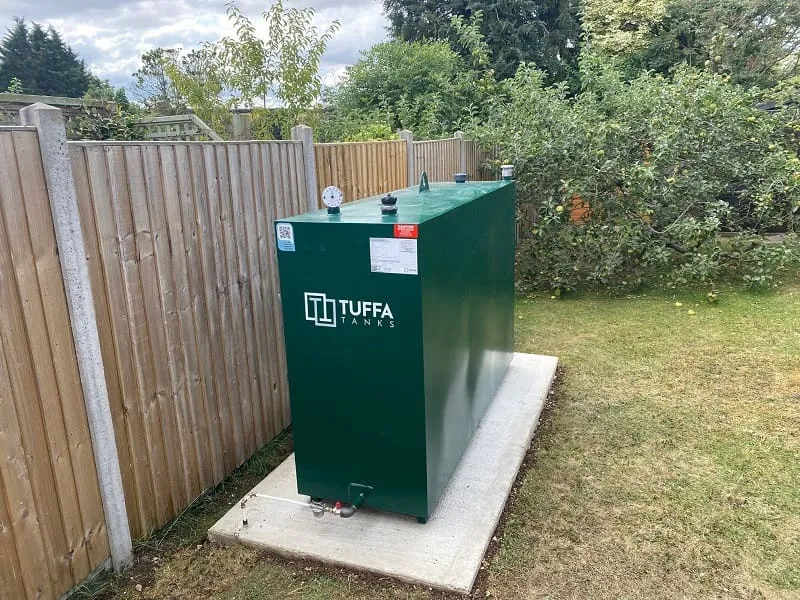Tuffa Tanks are a leading storage tank manufacturer. With 30 years experience manufacturing tanks including fuels, AdBlue®, chemicals and water, and with a large team of highly-skilled employees, we can honestly say we are industry experts.
Our Expert guide to HVO fuel tanks aims to inform you about what HVO is, the benefits of HVO, your storage options and more. We hope that some of you use this knowledge to help decarbonise your fuel and offer a range of storage solutions to help you do so.
WHAT IS HVO?
Hydrotreated Vegetable Oil (HVO) is a sustainable, low-carbon biofuel that derives from waste products. The fossil-free fuel is currently available as a drop-in alternative to mineral diesel, however, it will likely become commercially available as a replacement for kerosene to help decarbonise off-grid properties.
HOW IS HVO MADE?
As the name suggests, hydrotreated vegetable oil is produced by treating oils with hydrogen. This involves adding hydrogen to oil’s molecules and removing esters and contaminants from the fuel. The process makes a paraffinic fuel that is almost chemically identical to mineral diesel or kerosene but with many additional advantages over the fossil fuels.
WHAT CAN HVO BE MADE FROM?
HVO can be made from a mixture of vegetable oils and animals fats. HVO from reputable suppliers does not contain virgin palm oil and has been certified by the ISCC (International Sustainability and Carbon Certification) as a sustainable fuel. Waste products that HVO can be made from include:

WHAT ARE THE BENEFITS OF HVO?
There are many benefits of HVO when compared to mineral diesel, kerosene or even first generation biofuels. These benefits aren’t just to the environment and corporate social responsibility, but tangible benefits to your business and equipment. The advantages of HVO include:
Reduction in greenhouse gases and harmful byproducts
When compared to diesel or kerosene, HVO fuel reduces CO2 emissions by almost 90%. HVO usage also reduces nitrogen oxide (NOx) emissions by up to 27% and particulate matter (PM) emissions by up to 84%. This not only reduces greenhouse gas emissions but contributes to overall cleaner air.
Sustainably produced
HVO fuel is 100% renewable and has been certified by the International Sustainability and Carbon Certification (ISCC) as sustainable. It is also a second-generation biofuel which means that it derives entirely from waste products that would likely otherwise go to landfill. It should also be noted that the production of HVO from reputable suppliers does not contain any products which contribute to deforestation.
Safety
Pure hydrotreated vegetable oil is odourless, non-toxic and biodegradable. Therefore leaks and spills of HVO have a considerably less detrimental impact to the environment than diesel or kerosene. The flash point of HVO is also higher than mineral diesel which decreases the risk of a fire hazard.
Long storage life
HVO fuel is perfect for long-term fuel storage and can be stored for up to 10 years which makes it ideal for applications where long-term storage is required such as backup generators. As the hydrogenation process removes oxygen from the fuel, there is a significantly reduced risk of degradation or oxidation. HVO does not absorb water like first generation biofuels so does not provide an environment where diesel bug can thrive. This also removes the need for regular fuel testing and maintenance programs to remove water.
Cold weather performance
HVO has a considerably lower freeze point (-40°C) than diesel (-8°C). While this isn’t often a concern in the UK, it is one reason why HVO is so suitable for the decarbonisation of the aviation industry.
Compatibility
For most applications HVO is completely interchangeable with diesel and can completely replace diesel or be blended with diesel in any ratio. Many Original Engine Manufacturers (OEMs) including popular passenger car manufacturers, freight vehicle manufacturers and non-road vehicle manufacturers have approved the use of HVO fuel in their vehicle’s engines. If your vehicle has an OEM that has approved the fuel then there is no risk of voiding the warranty.
Using HVO for heating with existing oil-fired boilers will likely require only minor modifications to the boiler. Trials have shown the process is quick and relatively inexpensive at around £500.
Better for machinery
HVO’s clean-burning properties significantly reduced particulate production (up to 84%) which helps to improve the engine cleanliness, prolong the lifetime of emission control systems (where fitted) and decrease the ageing of engine oils. Additionally, as HVO does not react with water or oxygen, storage of the fuel avoids sludge build-up and diesel bug so prevents filters from blocking and contaminants entering your equipment.

WHAT IS THE DIFFERENCE BETWEEN HVO, DIESEL & FAME?
Mineral diesel is a fossil fuel made from refined crude oil. FAME is a first generation biofuel made from fresh organic matter. HVO is a second generation biofuel which is derived from sustainable waste products and emits up to 90% less CO2 emissions than mineral diesel. While the chemical composition of all three fuels is very similar, certain properties of HVO makes it cleaner, safer and improves the storage life. For example, HVO has higher cetane levels which means the fuel ignites faster and more completely giving the engine higher performance and producing fewer emissions.
Check out the table below to compare the properties of HVO with diesel and FAME:

WHAT DOES FIRST, SECOND AND THIRD GENERATION BIOFUEL MEAN?
First and second generation biofuels make up the vast majority of biodiesels sold in the UK while third generation biofuels are still in development. These are divided into types according to the material they are produced from.
First generation biofuels
First generation biofuels are produced from fresh organic matter such as rapeseed and cereals. Effectively, first generation biofuels use land to grow crops that could otherwise be consumed. Additionally, first generation biodiesel is made up of fatty acid methyl esters (FAME) so is also more susceptible to oxidisation and diesel bug.
Second generation biofuels
HVO is a second generation biofuel as it is produced from 100% waste products such as used cooking oils and animal fats. As HVO derives from waste products it is considered 100% sustainable and renewable. With no FAME or sulphur content HVO is a more stable than first generation biofuels which are susceptible to oxidation and diesel bug.
Third generation biofuels
There is currently greater research into and production of third-generation biofuels comprising of microalgae. If commercially viable, this could be particularly beneficial to carbon targets as microalgae can ‘absorb’ more carbon than trees. This process then creates more algae which can be converted into fuel suitable for industries including aviation
WHAT IS HVO USED FOR?
HVO has a wide range of applications making it suitable for many industries. It is currently commercially available as a diesel alternative and is compatible with most equipment including passenger cars, freight transport, agricultural machinery, boats and generators. HVO makes an ideal fuel to power backup diesel generators due to its long lifespan.
HVO is also suitable as a kerosene replacement or blend. While not yet commercially available, the fuel is being trialled across the UK to provide heating and cooking in domestic and non-domestic premises. More information is available in our article HVO for home heating – off the gird but on the radar.

The aviation industry has a severely limited choice of fuels that are viable for decarbonising commercial flights. However, the properties of HVO including the excellent cold weather performance makes it ideal for fuelling at high altitude.
WHAT TYPES OF HVO FUEL TANKS ARE THERE?
HVO dispensing tanks
HVO dispensing tanks are forecourt-style fuel dispensers that contain all the equipment needed to store, measure and dispense HVO or HVO diesel blends. All that these self-contained dispensers require is a solid concrete base and an electrical connection. However, we do manufacture plastic tanks with 12/24V pumps charged directly from your vehicle, so even mains electricity isn’t necessary.

Our HVO dispensing tanks are all bunded, compliant with UK regulations and are available in capacities from 1,350 to 100,000 litres as standard. Optional extras are also available to adapt the tank to individual site requirements. These include hose reels, higher flow rates, flowmeters and fuel management systems.
HVO storage tanks
HVO storage tanks are a simple bunded tank available with a top or bottom outlet (or a bespoke layout if required) and with the option of a cabinet in capacities from 3,500 litres. Our range of standard HVO fuel tanks come in capacities from 900 to 100,000 litres and are manufactured in plastic and steel. This is a cost-effective solution where integral dispensing isn’t required, for example for sites with existing external pumps.
HVO storage tanks are ideal when used as a backup power supply with a UPS system. This is because HVO has a long storage lifespan (up to 10 years) and does not require regular fuel maintenance to remove water or sludge.
At a time when HVO becomes commercially available as an alternative to kerosene for heating, our range of HVO storage tanks will be ideal for the safe and cost-effective storage of HVO heating oil.
Steel HVO fuel tanks
Steel HVO fuel tanks are very strong and hard-wearing with a long design lifespan of at least 30 years. These solid constructions provide more protection from fuel theft and impacts than plastic tanks. As they are hand fabricated (rather than using moulds) they are adaptable and can reach a high capacity.
However, the cost of the material and additional skilled labour required makes steel storage tanks more expensive than plastic. Also, while the design lifespan is longer than plastic tanks, steel tanks do require regular maintenance to prevent rust and keep them in optimum condition. For a full comparison of steel and plastic tanks, read our article Steel Vs Plastic Tanks – Virtues and Pitfalls.
Our steel HVO fuel tanks are hand-fabricated using a thick mild steel for both the primary tank and bund. To ensure maximum protection from leaks our steel tanks are ‘fully bunded’ with independent primary tank and bund – whereas some tanks on the market have a single base plate on the bottom of the tank, an area particularly susceptible to rust.
For storage only our steel tanks are available in capacities from 900 litres, or from 5,000 litres with dispensing equipment, and are available up to 100,000 litres. As standard, our steel HVO dispensing tanks are fitted with a high-security cabinet with a roller shutter door which houses premium ancillary equipment including a C2020 contents gauge with bund alarm, K33 mechanical flowmeter and 10 micron water and particulate filtration.

Plastic HVO fuel tanks
Our plastic HVO fuel tanks are bunded and rotomoulded using a durable, UV stabilized and corrosion-resistant polyethylene which makes a strong and safe single unit. These are available in capacities from 1,350 to 15,000 litres as a single tank or 30,000 litres using interlinking. Our plastic HVO storage tanks are designed to be simple to install and maintain with robust and easily replaceable ancillary equipment. Plastic HVO tanks are more cost-effective than steel but have a shorter design lifespan of 20 years and are an easier target for fuel theft.
Our plastic tanks come with a high-spec as standard with a high shot weight of polymer creating a thicker tank wall and premium ancillary equipment including flowmeter, 10-micron water and particulate filter and FMS gauge and bund alarm all housed within a lockable lid or cabinet. While the rotomoulding process creates a fixed tank size and shape, we do offer a variety of options to adapt the tank to the site’s individual requirements. These include a pulse meter, high flow rate pumping and fuel management.
CAN HVO BE USED AS A HEATING OIL?
The short answer is yes. After a year of successful trials converting domestic and commercial oil-fired boilers to burn HVO, a second phase of trials is underway to test the logistics of making it available to the mass market. Like HVO biodiesel, HVO heating oil (the same fuel but different application) reduces greenhouse gas emissions by nearly 90%. While not yet commercially available, HVO heating oil has been recognised in the UK’s Heat and Buildings Strategy (2021) as a route to decarbonise off-grid homes. HVO used for heating has numerous financial and practical benefits when compared to heat pumps. For more information check out our article HVO Heating Oil – a Drop-in Alternative to Kerosene?
WHAT SIZE HVO FUEL TANK DO I NEED?
Accurately calculating the size of fuel tank required can be difficult and depends upon the fuel efficiency of the machinery being used, the frequency and duration of use, and how often you expect to resupply the tank. Another consideration is purchasing a bigger tank than necessary to benefit from the extra storage and fluctuations in the price of HVO. This is a particularly feasible option if storing HVO100 as it can be stored for up to 10 years with little or no fuel maintenance.
WHAT ARE THE HVO FUEL STORAGE REGULATIONS?
In the UK there are no regulations specifically for HVO biodiesel. Although HVO is safer than mineral diesel or kerosene (as a non-toxic and biodegradable fuel) it follows the same regulations as regular oils. Everyone in the UK storing oil (including diesel, biodiesel, kerosene and blends) in a container with a capacity of over 200 litres must follow oil storage regulations.
Oil storage regulations specify that oil storage tanks above a certain capacity (depending upon the industry and country) must have a secondary containment system with the capacity to store a minimum of 110% of the primary tank’s contents. This is to capture any leaks from the primary tank and prevent oil from contaminating waterways and the environment. The table below can be used to check whether you need a bunded HVO storage tank:

DO I NEED A BUNDED HVO DIESEL TANK?
Additionally, you will require a secondary containment if the tank is sited in a location where oil spills could reach public water sources, including:
- Where oil spills could run over hard ground and reach coastal waters, inland fresh waters or a drinking water source.
- Where oil spills could run into an open drain or a loose manhole cover.
- Where the tank vent pipes cannot be seen when the tank’s being filled, for example, because the delivery tanker is parked too far away.
- Within 10 metres of coastal waters or inland fresh waters like lakes or streams.
- Within 50 metres of a drinking water source, for example, wells, boreholes or springs.
- In the inner zone of groundwater source protection zone 1
We always recommend buying a bunded tank or constructing a secondary containment for good environmental practice. Not only is it safer for the environment, but many insurance companies will not cover you for spills and leaks if the tank does not have an integral bund or external secondary containment.
WHICH MANUFACTURERS HAVE APPROVED HVO?
Due to the chemical composition of HVO being near identical to diesel, HVO works as a direct diesel replacement or blend in the vast majority of vehicles. Many Original Equipment Manufacturers (OEMs) have tested HVO in their vehicles and have approved HVO as a valid fuel. This means HVO100 can be used in the vehicle without invalidating the warranty. Here is a list of OEMs who have approved HVO in their vehicles:

While not all OEMs have approved HVO100 in their vehicles it should be noted that some blends of HVO meet EN590 fuel specification (the same as diesel) and can be used without requiring OEM approval.
To check whether your model of vehicle has been approved to use HVO100 please check your handbook or contact the manufacturer. To check whether a HVO diesel blend meets EN590 check with your fuel supplier.
HOW DO I MAINTAIN MY HVO FUEL TANK?
Our HVO diesel tanks are designed to be easily maintained with reliable ancillary equipment and filters which are easy to replace should the need arise. Our plastic tanks are rotomoulded with a higher than average shot weight giving them a thick tank wall and all of our steel tanks are fully bunded with a thick mild steel. The design of our tanks means that maintenance is simple and quick. Additionally, as HVO does not suffer from oxidation or diesel bug (unlike mineral diesel) then fuel maintenance programmes aren’t typically required.
As with all of our fuel tanks we do recommend regular inspections to achieve the full design life of the tank. This includes but is not limited to:
- Checking and replacing filters if necessary
- Inspecting plastic tanks for deformation including excessive bulging, stress fractures or splits
- Inspecting steel tanks for evidence of rust or heavy corrosion
- Check the bund alarm by activating the float switch
- Check the bund for water, spilt product and debris
HVO FAQs
HVO price per litre UK
Currently, HVO costs around 15% more than regular diesel. Any real savings are to the environment and through other benefits of HVO such as the increased storage time or improved corporate social responsibility.
Is HVO better than diesel?
HVO is better than diesel for many reasons. It is considerably better for the environment, it is sustainable, fossil-free, typically better for your engine and stores much better than mineral diesel.
Is HVO cheaper than diesel?
HVO is not cheaper than diesel, it costs around 15% more than regular mineral diesel. However, it depends how the cost is measured as the savings to the environment are much more substantial.
Can I use HVO in my car?
It is very likely you can use HVO in your car. However, if your car is in warranty then we recommend contacting your vehicle’s manufacturer to ensure they have approved the use of HVO.
Is HVO fuel renewable?
HVO fuel is renewable. This is because it is synthesized from renewable raw materials which can be regrown.
If you have any more questions about our HVO fuel tanks, or if you would like to enquire about prices and trade discounts, then please contact our sales team on 01889 567700, email [email protected] or complete the enquiry form below.ca






























